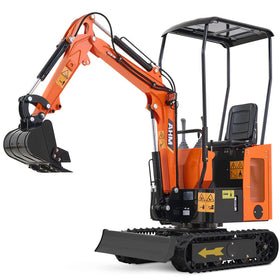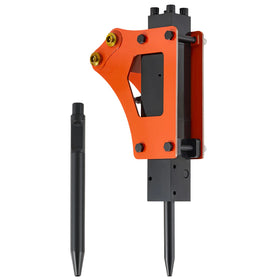Let's imagine you are in a construction project. After meticulously planning many steps, you have arrived at the most important part: getting the machinery. Mini excavators, also known as compact excavators, have become favorites due to their versatility and small footprint. You may have known about what digging depth means for a mini excavator, but how much weight can a mini excavator lift? To help you answer this question, this guide will cover several critical aspects of mini excavators’ lifting capacity, including what factors can affect their lifting capacity, how to calculate lifting capacity, and how to optimize lifting capacity for maximum efficiency.
What is Lifting Capacity?
Lifting capacity refers to the maximum weight a mini excavator can safely handle without compromising its stability or functionality. This capacity is crucial not only for operational efficiency but also for maintaining safety at the work site. Exceeding this limit can cause equipment damage, downtime, and potentially dangerous accidents. Thus, understanding the lifting limits of an excavator is essential for operators and potential buyers. Typically measured in pounds or kilograms, the lifting capacity of mini excavators varies by different models and manufacturers. Generally, mini excavators have a lifting capacity ranging from 1,000 to 20,000 pounds (450 to 9,000 kilograms).

What Factors Can Affect Mini Excavator Lifting Capacity?
Several key factors influence how much weight a mini excavator can lift. Understanding these can help operators maximize their machine's use while ensuring safety and efficiency:
- Hydraulic System: The power of the mini excavator’s hydraulic system, including the hydraulic pump and cylinders, is fundamental in determining how much weight the machine can lift. The efficiency of the hydraulic fluid’s flow rate and pressure directly impacts the force output of the system.
- Boom Length and Configuration: The length and type of the boom also significantly affect lifting capacity. Longer booms might offer an extended reach but often come at the cost of reduced lifting power. Conversely, shorter booms provide greater lifting capacity but limit reach.
- Counterweight and Stability: Properly balanced counterweights at the rear of the mini excavator are essential for enhancing stability during lifting operations. These counterweights help maintain the machine’s balance, preventing tipping and allowing it to lift heavier loads safely.
- Track Stability: The stability provided by the mini excavator’s tracks is another critical factor. A stable base is crucial when lifting heavy loads, as it prevents the machine from tipping or shifting, which could lead to accidents.
- Operating Radius: The distance from the center of the machine to the point where the load is lifted, known as the operating radius, also impacts lifting capacity. Generally, the lifting capacity decreases as the operating radius increases, requiring careful planning and positioning during operations.

How to Calculate the Lifting Capacity of Mini Excavators?
Determining the lifting capacity of your mini excavator might seem daunting, but you can always find your answer in the lift chart of your mini excavator:
- Review the Lift Chart: Read the lift chart for your specific mini excavator model, which is typically found in the machine's Operation and Maintenance Manual. This chart always lists the maximum safe lifting capacities at various boom angles and distances.
- Identify the Excavator's Configuration: Note your excavator’s setup. This includes the boom and arm length, the weight of attachments like buckets or couplers, and the overall configuration of the setup. All these factors can impact the lift capacity.
- Determine the Lift Point Height: Measure the vertical distance from the ground to the bucket’s pivot point (not to the actual loaded object). This measurement is crucial as it affects how much weight your excavator can lift safely.
- Find the Lifting Radius: Calculate the horizontal distance from the centerline of the swing point to the load. If your mini excavator is equipped with a dozer blade, assess whether the blade will be raised for mobility or lowered to enhance stability during lifting.
- Calculate Lifting Capacity: Take the Bobcat mini excavator lift chart as an example. Find where the lift point height intersects with the lifting radius on your lift chart. The corresponding value is your maximum lifting capacity for that specific setup.

How to Optimize Lifting Capacity for Maximum Efficiency?
To make the most of your mini excavator lifting capability, here are some practices that can be followed:
- Routine Maintenance: Regularly check and maintain your mini excavator’s hydraulic system, tracks, boom, and counterweights. Keeping these components in top condition can ensure your excavator can perform at its best.
- Accurate Load Calculations: Always accurately calculate the weight and balance of the load before lifting. This helps ensure that you stay within the safe lifting capacity and avoid stability issues or accidents.
- Training and Skill Development: Operators should receive comprehensive training on the excavator’s capacities and limitations. They need to understand how to read and interpret lift charts, as well as how to execute safe lifting operations.
- Use of Appropriate Attachments: Select the right attachments for your specific tasks. Using attachments designed for specific tasks can optimize the excavator’s performance, but please make sure that the attachments are compatible with your mini excavators.
In summary, understanding and calculating the lifting capacity of your mini excavator is crucial for safe and efficient operation. Knowing "how much weight can a mini excavator lift" can also help you select the right equipment for your specific needs. If you are considering purchasing or optimizing a mini excavator for a better lifting capacity, consulting with experts or manufacturers can provide valuable insights for you. AHM has high-quality mini excavators available now, where you can always be delighted to find your ideal excavator with the ideal lifting capacity. Come to visit AHM’s mini excavators today!







